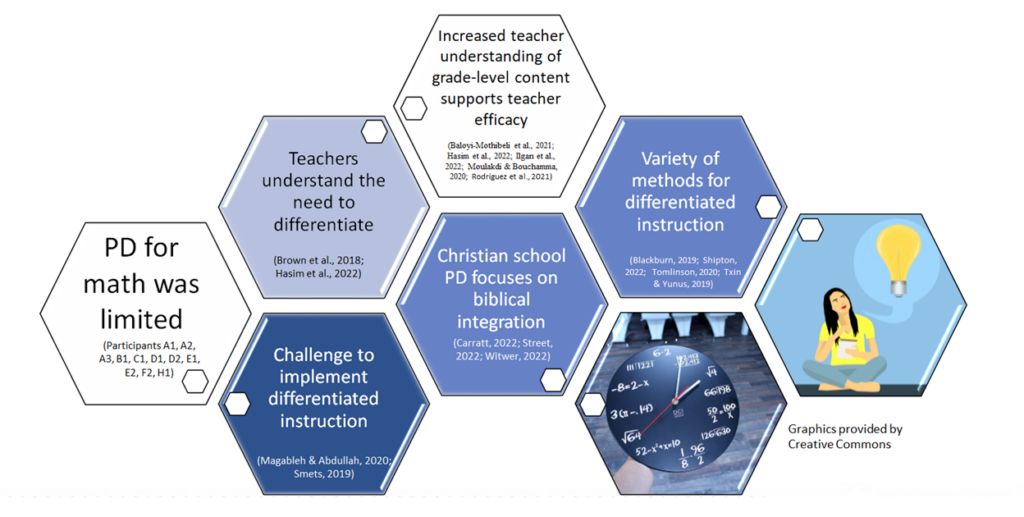 Math Instruction in Christian Schools: Teachers’ Perspectives
Math Instruction in Christian Schools: Teachers’ Perspectives
Several of my colleagues often share their struggles with teaching math. Our conversations prompted me to learn more about teachers’ perspectives on math instruction, specifically in the Christian school setting. I devoted my dissertation research to learning more about Christian school teachers’ experiences and perspectives about mathematics instruction. The study was completed in the Arizona Christian school community, and four research questions guided the work.
How do Arizona Christian school teachers explain their readiness for differentiating mathematics instruction?
Participants explained ways they differentiated math instruction: enrichment activities for higher-level learners, partner work, cooperative learning, small-group work, and tiered assignments. The reported readiness to differentiate instruction was accompanied by careful articulation of the challenge to meet all learners’ needs for mathematics. Teachers lamented students’ lack of automaticity with math facts and gaps in learning as primary obstacles to students’ success in math. Administrative support was widely acknowledged by teachers, and participants from four different schools cited a math block to provide leveled instruction for students as school-wide differentiated math instruction.

How do Christian school teachers in Arizona perceive their efficacy regarding math instruction?
Teachers’ efficacy to motivate students was mixed, but the perceived efficacy to meet higher learners’ needs was strong. Teacher efficacy was contingent on student performance both in class and on assessments. Teachers felt effective when they saw student success in math. Participants agreed efficacy for math instruction grew with experience.
How do teachers experience professional development in Christian schools in Arizona?
Professional development experiences in Christian schools varied across the participants and the schools represented. Although 11 participants initially indicated they had no professional development for math instruction, further discussion revealed that new math curriculum adoption was often accompanied by math professional development. Other frequently cited forms of PD included grade-level planning meetings, mentorships, and informal discussions among teachers.
How are professional learning communities and job-embedded professional development utilized in the Christian school setting in Arizona?
Participants representing two different schools indicated they met regularly in PLCs as a form of PD, and one participant shared a form of job-embedded professional development consisting of early release for students once a week, so teachers had dedicated time for PD. The use of PLCs and job-embedded PD in Christian school settings is an opportunity for future research.
Findings of the research compared to current literature
Literature indicated students have diverse learning needs and achieve different levels of math skill mastery (Brown et al., 2018; Hasim et al., 2022). Participants recognized the diverse learning needs of students and highlighted the challenges of providing math instruction to students who were below grade level, as well as the difficulty of keeping above-level students engaged and learning. Participants noted the challenge of implementing differentiated instruction in the classroom because of the diverse math learning needs of students. Differentiated methods reported by teachers reflected techniques highlighted in the literature, including cooperative learning, leveled math groups, and instruction responsive to students’ needs (Blackburn, 2019; Tomlinson, 2020; Txin & Yunus, 2019). Findings indicate teachers understood the need to differentiate math instruction and had a variety of methods for doing so, although the implementation challenges were pervasive. Respondents frequently reported problems involving a lack of instructional time and students who were below grade level or had not developed automaticity with math facts.
 Participants reported the PD they experienced for math instruction coincided primarily with new math curriculum adoption, identifying some content-based PD. Other than training with new curriculum adoption, participants reported receiving little to no formal PD focused on mathematics instruction. Participants noted a lack of ongoing training specifically for math content knowledge or training on implementing differentiated math instruction. Improving teachers’ understanding of both grade-level math content and pedagogy that meets the needs of all learners could improve teacher efficacy and translate to more favorable student outcomes (Baloyi-Mothibeli et al., 2021; Hasim et al., 2022; Ilgan et al., 2022; Moulakdi & Bouchamma, 2020; Rodríguez et al., 2021). Participants received training at their Christian schools for teaching a biblical worldview throughout content areas, including mathematics. Faith-based PD aligned with Christian school PD reported in the literature (Carratt, 2022; Street, 2022; Witwer, 2022).
Participants reported the PD they experienced for math instruction coincided primarily with new math curriculum adoption, identifying some content-based PD. Other than training with new curriculum adoption, participants reported receiving little to no formal PD focused on mathematics instruction. Participants noted a lack of ongoing training specifically for math content knowledge or training on implementing differentiated math instruction. Improving teachers’ understanding of both grade-level math content and pedagogy that meets the needs of all learners could improve teacher efficacy and translate to more favorable student outcomes (Baloyi-Mothibeli et al., 2021; Hasim et al., 2022; Ilgan et al., 2022; Moulakdi & Bouchamma, 2020; Rodríguez et al., 2021). Participants received training at their Christian schools for teaching a biblical worldview throughout content areas, including mathematics. Faith-based PD aligned with Christian school PD reported in the literature (Carratt, 2022; Street, 2022; Witwer, 2022).
Implications for Christian school leaders
The study’s findings offer implications for Christian school leaders regarding PD models that increase teacher efficacy and promote best practices for mathematics instruction. The research demonstrated effective PD has several important characteristics: collaborative, active, content-based, focused on student learning, job-embedded, ongoing, and reflective (Cavazos et al., 2018; Darling-Hammond et al., 2017; Kerbs, 2022; Krismanto et al., 2022; Wells et al., 2022).
Participants said supportive administrators provided feedback, modeled lessons, created schedules to maximize instructional time, and provided instructional materials. School leaders should intentionally seize PD time to boost teacher efficacy and model instructional practices with research-based, content-specific, engaging methods that highlight reflection as key to facilitating positive change (Attard, 2021; Avidov-Ungar & Zion, 2019; Brown et al., 2018; Magableh & Abdullah, 2020; Roumell, 2019).
Several teachers noted PD in best practices, specifying cooperative learning, differentiation, and engaging all learners. School leaders should incorporate math-specific content along with training in best practices to increase teacher efficacy in teaching mathematics. Training in how to incorporate differentiated methods is essential for implementation fidelity. Participants said they employed several methods of differentiated instruction for mathematics; however, the challenge of executing the methods in the classroom remained a problem of practice. Administrators should provide models of effective differentiation in math instruction to help teachers meet the challenge of implementing differentiated learning in math.
Conclusion
Teachers are busy professionals with incredibly complex work. Supporting their professional growth could yield a lasting impact on teachers’ well-being, student achievement, and the overall health of the organization. Teachers’ professional growth could be enhanced by embedding PD opportunities into the school day. Intentional administrative choices for training should be informed by teachers’ professional needs for growth. Schedules should support both differentiated learning and job-embedded PD to provide teachers with quality on-the-job training that is authentic, meaningful, and effective within their professional readiness levels.
References
Attard, C. (2021). Mathematics education: Who’s responsible? Australian Mathematics Education Journal (AMEJ), 3(4), 10. https://www.thefreelibrary.com/Opinion%3a+Mathematics+education%3a+who%27s+responsible%3f-a0498845395
Avidov-Ungar, O., & Zion, R. K. B. (2019). The characteristics and perceptions of teachers engaged in leading professional communities. Teacher Development, 23(3), 325–344. https://doi.org/10.1080/13664530.2019.1607772
Baloyi-Mothibeli, S. L., Ugwuanyi, C. S., & Okeke, C. I. O. (2021). Exploring grade R teachers’ mathematics curriculum practices and strategies for improvement: Implications for physics teaching. Cypriot Journal of Educational Sciences, 16(1), 238–250. https://files.eric.ed.gov/fulltext/EJ1288889.pdf
Blackburn, B. R. (2019). Ensuring rigour in a differentiated classroom. Australian Educational Leader, 41(1), 12–15. https://www.acel.org.au/ACEL/ACELWEB/Publications/AEL/2019/1/Lead_Article_2.aspx
Brown, B., Horn, R. S., & King, G. (2018). The effective implementation of professional learning communities. Alabama Journal of Educational Leadership, 5, 53–59. https://files.eric.ed.gov/fulltext/EJ1194725.pdf
Carratt, R. (2022). Developing a whole school approach to Christian living: A school story. Christian Teachers Journal, 30(1), 23–27. https://search.informit.org/doi/abs/10.3316/informit.346567597838838
Cavazos, L., Linan-Thompson, S., & Ortiz, A. (2018). Job-embedded professional development for teachers of English learners: Preventing literacy difficulties through effective core instruction. Teacher Education and Special Education, 41(3), 203–214. https://doi.org/10.1177/0888406418758465
Darling-Hammond, L., Hyler, M. E., Gardner, M., & Learning Policy Institute. (2017). Effective teacher professional development. Learning Policy Institute. https://doi.org/10.54300/122.311
Hasim, M. S., Rosli R., Halim L., Capraro M. M., & Capraro, R. M. (2022). STEM professional development activities and their impact on teacher knowledge and instructional practices. Mathematics, 10(7), Article 1109. https://doi.org/10.3390/math10071109
Ilgan, A., Aktan, O., & Üztemur, S. (2022). Focusing on sustainable development of teachers. Discourse & Communication for Sustainable Education, 13(1), 17–36. https://doi.org/10.2478/dcse-2022-0003
Kerbs, M. (2022). An honorary team member: The role of a literacy coach in supporting writing teachers. The Journal of Writing Teacher Education, 11(1). https://scholarworks.wmich.edu/wte/vol11/iss1/5
Krismanto, W., Kuswandi, D., Setyosari, P., & Praherdhiono, H. (2022). Social media-based professional learning: What are teachers doing in it? Qualitative Research in Education, 11(1), 89–116. https://doi.org/10.17583/qre.9698
Magableh, I. S. I., & Abdullah, A. (2020). On the effectiveness of differentiated instruction in the enhancement of Jordanian students’ overall achievement. International Journal of Instruction, 13(2), 533–548. https://doi.org/10.29333/iji.2020.13237a
Moulakdi, A., & Bouchamma, Y. (2020). Elementary schools working as professional learning communities: Effects on student learning. International Education Studies, 13(6), 1–13. https://doi.org/10.5539/ies.v13n6p1
Rodríguez, E. R., Osorio, B. B., & Soto, A. M. (2021). Identification of the principles of effective professional development programs and their impact: An investigation of the guidelines of a mathematics didactic graduate program and a case study focused on teacher training. International Journal of Science, Mathematics & Technology Learning, 29(1), 1–16. https://doi.org/10.18848/2327-7971/CGP/v29i01/1-16
Roumell, E. A. (2019). Priming adult learners for learning transfer: Beyond content and delivery. Adult Learning, 30(1), 15–22. https://doi.org/10.1177/1045159518791281
Shipton, B. (2022). Maximising PBL in police education: Why understanding the facilitator role is a key factor in developing learning for police problem-solving. Australian Journal of Adult Learning, 62(1), 56–75. https://ajal.net.au/downloads/maximising-pbl-in-police-education-why-understanding-the-facilitator-role-is-a-key-factor-in-developing-learning-for-police-problem-solving/
Smets, W. (2019). Challenges and checklists: Implementing differentiation. Agora, 54(2), 22–26. https://www.htav.asn.au/curriculum/2019/agora-2019-2-inclusion-and-differentiation
Street, M. (2022). Feeling capable and teaching Christianly: The sources of teacher self-efficacy in Christian Education National Schools. Christian Teachers Journal, 30(2), 4–9. https://search.informit.org/doi/abs/10.3316/informit.526003111055304
Tomlinson, C. A. (2020). Why differentiation is difficult: Reflections from years in the trenches. Australian Educational Leader, 42(2), 66–68. https://search.informit.org/doi/abs/10.3316/informit.439738140319972
Txin, C. X., & Yunus, M. M. (2019). The effects of Kagan cooperative learning structures in teaching subject-verb agreement among rural Sarawak learners. Arab World English Journal, 10(2), 151–164. https://doi.org/10.24093/awej/vol10no2.13
Wells, T., Chimka, M., & Gee, V. (2022). Teacher perspectives of professional development needs on trauma-informed practices. Kentucky Teacher Education Journal: The Journal of the Teacher Education Division of the Kentucky Council for Exceptional Children, 9(1). https://digitalcommons.murraystate.edu/ktej/vol9/iss1/2
Witwer, M. T. (2022). K-12 Christian school teachers’ perspectives on faith and learning. International Journal of Christianity & Education, 27(1), 6–26. https://doi.org/10.1177/20569971211065435
 About the Author:
About the Author:
Jeanette Wahlstrom has served in Christian education for over two decades. She has taught students in kindergarten through middle school and fulfilled the roles of director of curriculum and instruction and assistant principal. Jeanette earned her Ed.D. in Curriculum and Instruction with her dissertation research focusing on mathematics instruction in Christian education. She serves as the elementary principal at West Valley Christian School in Arizona, where her passion is seeing students grow as Jesus did—in wisdom and stature, and in favor with God and man (Luke 2:52).

